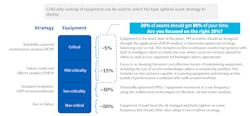How to develop a scalable preventive maintenance strategy
In a volatile market, there are very few levers to drive differentiation and profitability. Managing margins from within means a focus on efforts to avoid unplanned downtime, optimize maintenance spend and resources, and mitigate production losses.
The effectiveness of the maintenance and reliability function is particularly critical to the management of margins. In short, maintenance and reliability (M&R) groups ensure that equipment functions as needed to meet production requirements. To gain and maintain a competitive advantage in today’s business climate, companies must develop best practices and world-class strategies for how they drive these functions and capabilities with their organization.
Therefore, many operators turn to digital solutions to help them make advancements in these areas, including solutions that help them make better decisions around maintenance strategy development. A common challenge is that many companies begin this journey without first fully understanding the metrics they are trying to measure and improve to reach the stated objective.
When designing a preventive maintenance strategy to monitor the health of assets, goals should include minimizing data volumes across the network, defining baselines and alerting technicians to potential problems. The primary goal of the reliability function is to take work out of the system. Some metrics you might look at around this are:
- What is the percentage of reactive work? (Best in class is 5%.)
- What percentage of work is corrective vs preventive/predictive?
- Do we know what assets we are spending the most on? Is it warranted?
- Do we have important work not getting carried out?
All of these points can be valid metrics to help you understand where you need to focus. But like anything else, we must first understand the inherent problems operators face with preventive maintenance programs:
Excursions: An excursion in the manufacturing process due to failing components can impact production and forecasting, making it more difficult for the plant to meet goals and objectives. Understanding the health of equipment is critical to energy efficiency, forecasting, production and worker productivity. Companies have increased uptime substantially by ordering replacement parts upon potential failure detection and proactively replacing them before the excursion or failure occurs.
The OEM Plan: Nearly every piece of equipment designed into a plant or process comes with a recommended preventive maintenance plan from the OEM. Manufacturer preventative maintenance plans do not always consider the unique process and operating parameters with which the operator is going to leverage the asset. As a result, OEM plans need to be adjusted from an interval or tactical standpoint to best address the operating context of the asset.
Excessive maintenance costs: When budgets become tight, what is the first thing that gets cut after training? Preventive maintenance. Reliability managers are tasked with determining what preventive maintenance plans can be cut without having a major impact on production and reliability, and in many cases have a spreadsheet of work history and sporadic failure code documentation for how to make these decisions. And again, the plan is altered — not strategically, but reactively due to budget constraints.
Manual, labor-intensive processes: Relying on the process of having humans visually check asset health can be costly over time. In the past, a technician manually checked the asset to determine if it was operating differently from the previous day. This lack of data made it difficult to identify anomalies and increase the risk of error
Paper intensive process: Many organizations have extensive operator rounds programs with check sheets and clipboards for assets to be walked down and have basic preventive maintenance tasks performed. The challenge with this process is the data collected is incomplete and, in many cases, ends up collecting dust in the filing cabinet.
Strategic steps forward
Strategies can start with connecting unconnected and interconnected intelligent devices to reduce strain on the network. In addition, companies can develop functionality that moves capabilities to the edge that will help to scale solutions as monitoring solutions grow.
Companies could also perform analytics at the edge while collecting summary level data for long-term trend analysis in the cloud.
With the advent of cheaper sensor technologies and highly accurate software solutions that can detect certain degradation on equipment, condition monitoring has become much more cost effective. The question becomes, have we adjusted our preventive maintenance plan and strategies accordingly based on the conditional systems we may have retrofitted onto a percentage of the asset base.
When you step back from these challenges that exist with preventive maintenance, a couple of questions come to mind:
- Do I have documentation as to why and how we evolved the plan over time?
- Can I quantify changes to the strategy, or quantify not changing strategy, based on potential risk?
- How should strategies be rationalized when new technologies and methods are implemented around an asset? Should my preventive maintenance program stay the same?
- Do we have a digital paper trail around our assets and understanding of asset health?
Companies are struggling to take a step forward from their reactive or “firefighting” maintenance cultures that are driving these inefficiencies. Once companies begin asking themselves these questions, they will begin to understand how digital solutions and associated asset strategies can help. To force a step-change, companies must take a strategic approach to asset management. When it comes to driving cost efficiency and reliability improvements, leading adopters are letting risk guide their strategy and decision making.
Risk: The convergence of predictive and preventive maintenance
Most of your business risk will reside within a subset of your total asset base. Quantifying the risk an asset presents to business, and focusing efforts accordingly, allows you to ensure that assets with significant consequences for failure scenarios or those assets subject to legal and statutory requirements have a complete and optimized management strategy.
Through this lens of risk comes a significant opportunity for reliability teams to converge both preventive and condition-based maintenance activities to drive cost optimization and reliability improvements. This approach enables a quantitative risk assessment methodology to be the driving factor for determining the right recipe of preventive maintenance (PMs), and condition-based technologies and tactics that should be applied to an asset or system.
Technologies like Asset Performance Management (APM) are equipping engineers to sustain these methodologies and answer the key questions outlined above. Not only can these technologies help teams develop and deploy comprehensive asset strategies based on risk, but they can also enable them to track the effectiveness of strategies over time. This will help companies to understand how strategies evolve as business conditions change, assets age and new technologies and methodologies emerge.
Software solutions like APM can also help companies collaborate across functional teams to make better operational and maintenance decisions. They also provide the ability to develop and retain best practices from an ever-changing workforce to continuously improve decision making.
APM connects disparate data sources and uses advanced analytics to turn data into actionable insights while fostering collaboration and knowledge-management across an organization. There are APM solutions that work across all equipment, all OEMs and all industries, across the plant, and across the fleet. APM gives organizations the flexibility to develop new analytics and applications, making it versatile to meet changing needs.
Jared Hartness is a senior industry marketing leader for oil and gas with GE Digital, working with GE’s Asset Performance Management suite of solutions. Prior to joining GE Digital, Hartness began his career with Meridium, serving in capacities ranging from product marketing, marketing programs and digital marketing for their asset performance management software solutions. He earned a bachelor’s degree in communication and media studies from Radford University.


